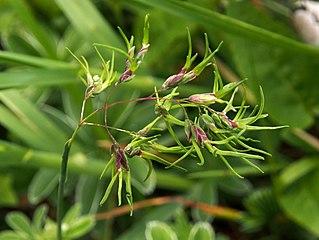
Poa is a genus of about 570 species of grasses, native to the temperate regions of both hemispheres. Common names include meadow-grass, bluegrass, tussock, and speargrass. Poa is Greek for "fodder". Poa are members of the subfamily Pooideae of the family Poaceae.

Poa trivialis, is a perennial plant regarded in the US as an ornamental plant. It is part of the grass family.

Tussock grasses or bunch grasses are a group of grass species in the family Poaceae. They usually grow as singular plants in clumps, tufts, hummocks, or bunches, rather than forming a sod or lawn, in meadows, grasslands, and prairies. As perennial plants, most species live more than one season. Tussock grasses are often found as forage in pastures and ornamental grasses in gardens.
Snow grass is a common name for several plants and may refer to:

Tussock grasslands form expansive and distinctive landscapes in the South Island and, to a lesser extent, in the Central Plateau region of the North Island of New Zealand. Most of the plants referred to as tussocks are in the genera Chionochloa, Festuca, and Poa, also Carex.

Sporobolus virginicus, known by numerous common names including seashore dropseed, marine couch, sand couch, salt couch grass, saltwater couch, coastal rat-tail grass, and nioaka, is a species of grass with a wide distribution.

Poa compressa, the Canada bluegrass or flattened meadow-grass, is a perennial flattened meadow grass, similar to common meadow-grass, Poa pratensis. It is native to Europe but it can be found nearly worldwide as an introduced species. It grows in old wall tops, pavement cracks, dry stony grassland, and many types of wild habitat. It has a flattened stem, 23–30 cm tall, a close one sided panicle of grey green, with purple florets.

Poa alpina, commonly known as alpine meadow-grass or alpine bluegrass, is a species of grass with a primarily holarctic distribution.

Poa foliosa is a species of tussock grass commonly known as muttonbird poa. It is native to the subantarctic islands of New Zealand and Australia.

Poa cookii, sometimes called Cook's tussock-grass or bluegrass, is a species of tussock grass native to various subantarctic islands. The specific epithet honours British explorer James Cook who visited the Kerguelen Islands in 1776.
Wīwī is a common name for several species of New Zealand rushes and sedges whose individual plants grow as a clump with wire-like stems. The name wīwī has been adopted in English from the Māori language.
The Burrinjuck Nature Reserve is a protected nature reserve on the south west slopes of New South Wales, Australia. The 5,250-hectare (13,000-acre) reserve is located adjacent to the Burrinjuck Dam, with 5,118 hectares of the reserve located on the northern side of the reservoir, and the remaining 89 hectares located on the southern side of the reservoir to the northeast of Black Andrew Nature Reserve. It includes land formerly managed as the Burrinjuck State Forest and Burrinjuck State Recreation Area.

Gahnia sieberiana, commonly known as the red-fruit saw-sedge, is a tussock-forming perennial plant in the family Cyperaceae, endemic to Australia. It is a widespread plant that favours damp sunny sites. Many insect larvae have been recorded feeding on the red-fruit saw-sedge. It may grow over 2 metres tall.

Poa poiformis, commonly known as coast tussock-grass or blue tussock-grass, is a densely tufted, erect, perennial tussock grass, with distinctive blue-green leaves, that grows to about 1 m in height. Its inflorescences are arranged in a dense panicle up to 30 cm long. It is native to coastal southern Australia where it occurs along ocean foreshores, estuaries, dunes and cliffs. P. poiformis is also found on Kangaroo Island and Lord Howe Island.

Poa labillardierei, also known as common tussock-grass, is a species of tussock grass that is endemic to Australia. It is found in southern and eastern Australia, including Tasmania. There are differing variations, Poa labillardierei var. acris Vickery and Poa labillardierei Steud. var. labillardierei.
Poa ensiformis, commonly known as sword tussock-grass or purple-sheathed tussock-grass, is a species of tussock grass that is endemic to Australia.
Poa morrisii, commonly known as soft tussock-grass is a species of tussock grass that is endemic to Australia.
The Queanbeyan Nature Reserve is a protected nature reserve that is located in the Southern Tablelands region of New South Wales, in eastern Australia. The 67-hectare (170-acre) reserve is situated approximately 4 kilometres (2.5 mi) west-south-west of the City of Queanbeyan.

Sclerochloa is a genus of Eurasian and North African plants in the grass family. Hardgrass is a common name for plants in this genus.

Poa cuspidata, commonly called early bluegrass, is a species of flowering plant in the grass family (Poaceae). It is native to the eastern United States, where its range extends from Appalachian regions into the Coastal Plain, where it is less common. In the Appalachian mountains, it is a common species found in forest openings.














